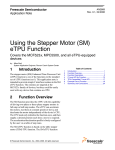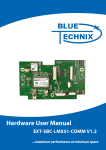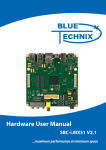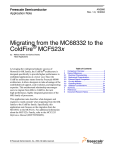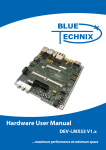Download IEEE 1588 Implementation on a ColdFire Processor
Transcript
Freescale Semiconductor Application Note AN3625 Rev. 0, 06/2008 IEEE 1588 Implementation on a ColdFire Processor by: Michal Princ System Application Engineer Roznov Czech System Center 1 Introduction This application note describes implementation of the IEEE® 1588 Precision Time Protocol (PTP) on the ColdFire® processor. The solution uses a hardware platform comprising Freescales's ColdFire family MCF5234 microprocessor and the National Semiconductor DP83640 PHYTER® High Precision – IEEE 1588 Single Port Fast Ethernet Transceiver that supports hardware time-stamping of Ethernet packets. The demo application uses the new M5234BCC low cost evaluation board. The demo software uses the IEEE 1588 protocol stack supplied by IXXAT Automation and a TCP/IP stack supplied by CMX Systems. This document discusses the following topics: • PTP basics • ColdFire solution • Description of the demo application © Freescale Semiconductor, Inc., 2008. All rights reserved. Contents 1 2 3 4 5 Introduction . . . . . . . . . . . . . . . . . . . . . . . . . . . . . . . . . . . 1 IEEE 1588 Basic Overview . . . . . . . . . . . . . . . . . . . . . . . 2 2.1 Synchronization Principle . . . . . . . . . . . . . . . . . . . . 3 IXXAT IEEE 1588 Protocol on ColdFire . . . . . . . . . . . . . 5 Description of the Demo Application . . . . . . . . . . . . . . . . 7 4.1 Demo Concept. . . . . . . . . . . . . . . . . . . . . . . . . . . . . 7 4.2 ColdFire MCF523x Microprocessor. . . . . . . . . . . . . 9 4.3 M5234BCCKIT: Business Card Controller KIT . . . 11 4.4 IXXAT IEEE 1588 PTP Protocol Software. . . . . . . 12 4.5 User Interface . . . . . . . . . . . . . . . . . . . . . . . . . . . . 13 4.6 Measuring the Clock Synchronicity . . . . . . . . . . . . 19 4.7 Microprocessor Usage. . . . . . . . . . . . . . . . . . . . . . 20 Conclusion. . . . . . . . . . . . . . . . . . . . . . . . . . . . . . . . . . . 21 IEEE 1588 Basic Overview 2 IEEE 1588 Basic Overview The IEEE 1588 standard is known as Precision Clock Synchronization Protocol for Networked Measurement Control Systems, or PTP for short. The IEEE 1588 PTP allows clocks distributed across an Ethernet network to be accurately synchronized using a process where the distributed nodes exchange timestamped messages. The technology behind the standard is originally developed by Agilent and used for distributed measuring and control tasks. The challenge is to synchronize networked measuring devices with each other in terms of time, therefore able to record measured values providing them with a precise system timestamp. Based on this timestamp, the measured values can then be correlated with each other. Typical applications of the IEEE 1588 time synchronization include: • Time-sensitive telecommunication services that require precision time synchronization between communicating nodes • Industrial network switches that synchronize sensors and actuators over a single wire distributed control network to control an automated assembly process • Powerline networks that synchronize across large-scale distributed power grid switches to enable smooth transfer of power • Test/measurement devices that must maintain accurate time synchronization with the device under test in many different operating environments These applications require precise clock synchronization between devices with accuracy in the sub-microsecond range. It is a remarkable feature of the IEEE 1588 that this synchronization precision is achieved via the regular Ethernet connectivity using standard Ethernet frames. This must be assumed to be non real-time capable. This solution allows nearly any device of any performance to participate in high precision synchronized networks that are simple to operate and configure. Other key benefits of the IEEE 1588 protocol include: • IEEE 1588 protocol enables rapid convergence (less than a minute) to sub-microsecond time synchronization between heterogeneous distributed devices with different clocks, resolution, and stability. • The IEEE 1588 network configures and segments itself automatically. Each node uses the best master clock algorithm (BMC) to determine the best clock in the segment. Every PTP node stores its features within a specified dataset. These features are transmitted to other nodes within its sync telegrams. Based on this, other nodes are able to synchronize their datasets with the features of the actual master and can adjust their clocks. Due to the cyclic running of the BMC, nodes can also be connected or removed during propagation time (hot swapping). • Simple configuration and operation with low compute resource and network bandwidth consumption IEEE 1588 Implementation on a ColdFire Processor, Rev. 0 2 Freescale Semiconductor IEEE 1588 Basic Overview 2.1 Synchronization Principle In Ethernet systems, unpredictable collisions due to the CSMA/CD procedure may lead to time packages being delayed or disappearing completely. For this reason, the IEEE 1588 defines a special clock synchronization procedure. The process starts with one node (master clock) transmitting a sync telegram that contains the estimated transmission time. The exact transmission time of the sync telegram is captured by a clock and transmitted in a second follow up message. By comparing the timestamp information contained within the first and second telegrams against its own clock, the receiver can calculate the time difference between its own clock and the master clock, see Figure 1. Sync and follow-up messages are sent as multicast. System A (Master) System B (Slave) t0 t0 = timestamp of sync msg sent t0 value sent in follow-up msg sync m sg t1 t1 = timestamp of sync msg received follow -u (includ p msg es t0) Equation 1: t1 - t0 = offset + delay Figure 1. Offset and Delay Measurement — Sync Message, Follow-Up Message The telegram propagation time is determined cyclically in a second transmission process between the slave and the master (delay telegrams). The slave can then correct its clock and adapt it to the current bus propagation time, see Figure 2. Delay_req and delay_resp messages are point-to-point but sent with a multicast address for simplicity. IEEE 1588 Implementation on a ColdFire Processor, Rev. 0 Freescale Semiconductor 3 IEEE 1588 Basic Overview System A (Master) t3 System B (Slave) _requ delay msg t2 t2 = timestamp of delay_req msg sent delay_ re (includ sp msg es t3) t3 = timestamp of delay_req msg received Equation 2: t3 – t2 = delay - offset Figure 2. Offset and Delay Measurement — Delay Messages Figure 3 serves as an example of the IEEE 1588 synchronization message sequence. 100 102 104 Master Clock PTP Appl. G/MII t0 Estimated Send Time (100) Precise Send Time (101) Slave Clock G/MII PTP Appl. 104 SYNC(100?? ) t1 FOLLOW_U P(101!) 106 t3 B DELAY_REQ t2 108 110 112 Precise Receive Time (108) DELAY_RES P(108) Key Equations: Example: A = t1 – t0 = Delay + Offset A = 106 – 101 = 5 B = t3 - t2 = Delay – Offset B = 108 – 111 = -3 Delay = (A+B) / 2 Delay = (5-3) / 2 = 1 Offset = (A-B) / 2 Offset = (5+3) / 2 = 4 A 106 Precise Receive Time (106) 108 Offset Computation 110 Precise Send Time (111) 112 114 116 UDP port 319: Sync and Delay_Req UDP port 320: Follow_up, Delay_Resp, and Mgmt Figure 3. IEEE 1588 Synchronization Message Sequence For more information about the IEEE 1588 standard, visit the web page for the National Institute of Standards and Technology. IEEE 1588 Implementation on a ColdFire Processor, Rev. 0 4 Freescale Semiconductor IXXAT IEEE 1588 Protocol on ColdFire 3 IXXAT IEEE 1588 Protocol on ColdFire The PTP protocol can be implemented in software using a standard Ethernet module. However, because the timestamp information is applied at the application level, the delay fluctuation introduced by the software stack running on both master and slave devices mean that only a limited precision can be achieved, see Figure 4. Now, it's 9:28 ! Master Clock Slave Clock OK, thanks 9:28 ! Variable delay introduced by the Network due to the topology: PTP Milliseconds of delay and variation introduced by protocol stack UDP IP •Hundreds of nanoseconds to microseconds for repeaters & switches •Milliseconds for routers MAC PHY PTP Packet PTP UDP IP MAC Network Milliseconds of delay and variation introduced by protocol stack PHY Now it's 9:28 Figure 4. Software Timestamp Implementation Master Clock Slave Clock OK, thanks 9:28 ! Now, it's … PTP PTP UDP UDP IP IP MAC MAC PHY Network PHY … 9:28 ! PTP Packet Now it's 9:28 Figure 5. Hardware Timestamp Implementation IEEE 1588 Implementation on a ColdFire Processor, Rev. 0 Freescale Semiconductor 5 IXXAT IEEE 1588 Protocol on ColdFire It is possible to minimize the impact of the protocol stack delay by generating/marking timestamps as close as possible to the physical interface boundary, see Figure 5. Dedicated hardware time-stamping allows synchronization with significantly improved precision achieved. Freescale Semiconductor’s ColdFire M5234BCC Evaluation Board with the National Semiconductor DP83640 PHYTER High Precision – IEEE 1588 Single Port Fast Ethernet Transceiver serves as an HW platform that fulfills these requirements. Together with the IEEE 1588 PTP protocol software from IXXAT the leading industrial protocol vendor, this allows customers to develop precise IEEE 1588 solutions. Figure 6 describes the hardware and software components of this joint solution. Application Management Slave SIS Control (Best Master Clock Algorithm) Master Dispatcher Time Stamp Unit (TSU) IXXAT IEEE 1588 Engine Network Interface Clock Interface (CIF) CMX TCP/UDP/IP Fast Ethernet Controller MCF5234 MII MII Time Stamp Insertion Adjustable HW Clock NSC DP83640T PHYTER® Ethernet Figure 6. IEEE 1588 Protocol Implementation on ColdFire This system relies on timestamp insertion and an adjustable HW clock. Both are implemented by DP83640 PHYTER. The PHYTER IEEE 1588 transmit parser monitors transmit packet data to detect IEEE 1588 version 1 and version 2 event messages. After any PTP event message is detected, the device captures the transmit timestamp and provides it to the IXXAT IEEE 1588 stack software through the media independent interface (MII). Similiarly, the PHYTER receive parser monitors receive packet data to detect IEEE 1588 version 1 and version 2 event messages. Upon detection of a PTP event message, the device captures the received timestamp, inserts it into the received packet at fixed locations within the PTP message, and passes the whole message through the MII to the IXXAT IEEE1588 stack software. This is how received timestamps are delivered to the IXXAT IEEE 1588 engine. The IXXAT IEEE 1588 engine of the slave device processes all the PTP received messages. It makes adjustments to its own clock (the DP83640 PHYTER IEEE 1588 clock) based on the extracted timestamps. The method used to update the DP83640 PHYTER clock value depends on the difference in IEEE 1588 Implementation on a ColdFire Processor, Rev. 0 6 Freescale Semiconductor Description of the Demo Application the clock time values. During the initial synchronization stage while the master and slave clocks are far apart, a step adjustment or a direct time set is applied. Later, when the time difference between the master clock and the slave clock is smaller, the rate adjustment (clock frequency adjustment) method is used. Setting the DP83640 PHYTER registers is performed through the MII interface. 4 Description of the Demo Application 4.1 Demo Concept The demo application showing the PTP implementation on ColdFire processors consists of several boards and components. Some of these are essential and others are optional. The minimum configuration includes: • M5234BCC board with the PTP stack configured as the master device • M5234BCC board with the PTP stack configured as the slave device • PC with the FreeMASTER software, serial line cable/P&E USB Multilink debug module • Power supplies, Ethernet crossover type cable • Oscilloscope (optional) The demo can be configured in a back-to-back (point-to-point) configuration where two boards are connected directly using the crossover Ethernet cable. This deals with a simple type of connection often used for evaluating the system accuracy and the overall performance. The user interface to the applications running on both the master and the slave is managed through the FreeMASTER GUI. FreeMASTER is a visualization tool that runs on a PC. There are two ways to establish the connection between FreeMASTER (running on the PC) and the BCC boards, through a standard RS-232 serial line, or through the P&E USB BDM Multilink debugger. The back-to-back configuration is illustrated in Figure 7. It is possible to extend the system to include additional PTP slaves (one or several). An Ethernet switch provides the connection between all ColdFire BCC boards. As an alternative to the FreeMASTER GUI, a Telnet console can be used for monitoring and control of the PTP activities. Figure 8 shows a configuration with one master and two slave devices. This is the concept used in creating the Freescale ColdFire MCF5234 Based IEEE 1588 Precision Time Protocol demo, see Figure 9. The M5234BCC board with the blue Ethernet connector is loaded with the PTP stack and is configured as a master. The other two M5234BCC boards are loaded with the PTP stack and are configured as slaves. The demo can work equally well if one of the BCC slaves or the BCC master is replaced by the PowerQUICC processor family with NSC PHYTER (in some cases without it, where the hardware timestamp is built into the PowerQUICC MAC). For more information about the developed PowerQUICC based IEEE 1588 systems go to www.freescale.com. IEEE 1588 Implementation on a ColdFire Processor, Rev. 0 Freescale Semiconductor 7 Description of the Demo Application FreeMASTER M5234BCC IEEE1588 Master PPS signal Crossover Ethernet cable RS232 or P&E USB Multilink FreeMASTER M5234BCC IEEE1588 Slave Figure 7. Back-to-Back Configuration of the Demo M5234BCC IEEE1588 Master Telnet console Ethernet Network Switch RS232 or P&E USB Multilink PPS signal FreeMASTER M5234BCC IEEE1588 Slave M5234BCC IEEE1588 Slave Figure 8. Demo Extended to Include Multiple Nodes IEEE 1588 Implementation on a ColdFire Processor, Rev. 0 8 Freescale Semiconductor Description of the Demo Application Figure 9. Freescale ColdFire MCF5234 Based IEEE 1588 Demo 4.2 ColdFire MCF523x Microprocessor The MCF523x is a family of highly-integrated 32-bit microprocessors based on the V2 ColdFire core. It features a 16- or 32-channel enhanced time processor unit (eTPU), 64 Kbytes of internal SRAM, a 2-bank SDRAM controller, four 32-bit timers with DMA request capability, a 4-channel DMA controller, up to two CAN modules, three UARTs, and a queued SPI. The MCF523x family has been designed for general-purpose industrial control applications. This 32-bit device is based on the V2 ColdFire reduced instruction set computer (RISC) core operating at a core frequency of up to 150 MHz and a bus frequency of up to 75 MHz. On-chip modules include the following: • V2 ColdFire core with an enhanced multiply-accumulate unit (EMAC) providing 144 Dhrystone 2.1 MIPS at 150 MHz • eTPU with 16 or 32 channels, 6 Kbytes of code memory, and 1.5 Kbytes of data memory with eTPU debug support • 64 Kbytes of internal SRAM • External bus speed of half the CPU operating frequency (75 MHz bus at 150 MHz core) • 10/100 Mbps bus-mastering Ethernet controller IEEE 1588 Implementation on a ColdFire Processor, Rev. 0 Freescale Semiconductor 9 Description of the Demo Application • • • • • • • • • • • • • • • • • • 8 Kbytes of configurable instruction/data cache Three universal asynchronous receiver/transmitters (UARTs) with DMA support Controller area network 2.0B (FlexCAN module) Optional second FlexCAN module multiplexed with the third UART Inter-integrated circuit (IIC) bus controller Queued serial peripheral interface (QSPI) module Hardware cryptography accelerator (optional) Random number generator DES/3DES/AES block cipher engine MD5/SHA-1/HMAC accelerator 4-channel, 32-bit direct memory access (DMA) controller 4-channel, 32-bit input capture/output compare timers with optional DMA support 4-channel, 16-bit periodic interrupt timers (PITs) Programmable software watchdog timer Interrupt controller capable of handling up to 126 interrupt sources Clock module with phase locked loop (PLL) External bus interface module including a 2-bank synchronous DRAM controller 32-bit, non-multiplexed bus with up to eight chip select signals that support page-mode FLASH memories Figure 10. MCF523x Family For more information, refer to MCF523x Reference Manual, MCF5235RM. IEEE 1588 Implementation on a ColdFire Processor, Rev. 0 10 Freescale Semiconductor Description of the Demo Application 4.3 M5234BCCKIT: Business Card Controller KIT The M5234BCCKIT offers a complete low-cost method for evaluation of the Freescale MCF5234 ColdFire microprocessor. It is similar to the M5235BCCKIT but includes the DP83640T PHYTER High Precision – IEEE 1588 Precision Time Protocol (PTP) Single Port Fast Ethernet Transceiver, supplied by National Semiconductor. The M5234BCC module comes with: • 10/100TX Ethernet port with the NSC DP83640T PHYTER, IEEE 1588 capability, RJ45 connector, three status indicators, and an auto connection detection. • 2 MByte flash (16-bit, external) • 16 MBytes SDRAM (32-bit, external) • 25 MHz reference crystal, up to 100 MHz operation • MCU Port, 50-pin GPIO port with 1 x 1Mb CAN I/O • ETPU Port, 20 pins, and 16 channels with +V supply • BUS port, 34 pins, 64 K address, 8-bit data bus, and three selects • BDM / JTAG Port, 26 pins, and a development port • COM Port (UART0) with RS232 DB9-S ribbon connector • CAN port with 1 Mbaud transceiver on the MCU Port • RESET switch and indicator • ABORT (IRQ7) switch • Regulated +3.3V and +1.5V power supply with indicator While the M5234BCCKIT specifically incorporates the National Semiconductor DP83640 PHYTER, the IEEE 1588 capability can be easily supported on any Ethernet-enabled ColdFire device. The standard Ethernet controller used across the ColdFire family combined with the National Semiconductor DP83640 PHYTER allows the IXXAT Automation IEEE 1588 stack and the CMX TCP/IP stack to be ported to any ColdFire device with minimal effort. For more information about the M5234 Business Card Controller KIT, refer to the M5234BCC Board's User Manual, M5234BCCUM. The DP83640 Precision PHYTER device delivers high precision clock synchronization for real time industrial connectivity based on the IEEE 1588 standard. The DP83640 has deterministic low latency and can be interfaced easily to any other device within the ColdFire or PowerQUICC family with no further hardware customization. The integrated IEEE 1588 functionality allows system designers the flexibility and precision of a close-to-wire timestamp. The DP83640 PHYTER supports the IEEE 1588 real time Ethernet applications by providing hardware support for three time critical elements. • IEEE 1588 synchronized clock generation • Packet timestamps for clock synchronization (8 ns resolution) • Event triggering and timestamping through GPIO By combining the capabilities described above, the DP83640 provides advanced and flexible support for systems using IEEE1588. IEEE 1588 Implementation on a ColdFire Processor, Rev. 0 Freescale Semiconductor 11 Description of the Demo Application The DP83640 provides features for controlling the clock operation in slave mode. The clock value can be updated to match the master clock in several ways. The clock can also be programmed to adjust its frequency to compensate for drift. The DP83640 supports real time triggering activities and captures real time events to report to the microcontroller. Controlled devices can be connected to the DP83640 through GPIO pins. For a more detailed discussion on configuring the IEEE 1588 features, refer to the National Semiconductor Ethernet PHYTER® Software Development Guide, available at NSC web pages. 4.4 IXXAT IEEE 1588 PTP Protocol Software The IEEE 1588 protocol software enables simple rapid development of IEEE 1588 compliant devices. Developed by IXXAT Automation GmbH, the IEEE 1588 protocol software has a modular structure ensuring fast integration into the target system. For access to the UDP/IP socket, the interfaces to the target platform are compiled in a separate adaptation layer (network interface) considerably simplifying porting to the target system, see Figure 6. The software is completely independent of the operating system and therefore can also be used in applications without an operating system (superloops). The only requirement is a multicast-compatible UDP/IP stack. The portable embedded TCP/IP stack developed by CMX Systems, Inc., is chosen for this demo application. 4.4.1 Functionality The IEEE 1588 V1 software package includes a full implementation of the standard for Ethernet with the following functionality: • Ordinary clock • Boundary clock • Best master clock algorithm • Configuration and scaling via central configuration file • Management API 4.4.2 Platform Requirements The platform must support a few basic features suitable for IEEE 1588 software porting: • TCP/IP stack — The TCP/IP stack must provide a standard UDP interface. The transmitting and receiving functions must provide a non-blocking mode. The options IP_ADD_MEMBERSHIP, IP_DROP_MEMBERSHIP, and SO_REUSEADDR are required. For implementations using more than one channel to Ethernet segments, the option IP_MULTICAST_IF is required. • Timer — The IEEE 1588 stack uses an internal timer module. The platform must trigger this module with an interval of 20 milliseconds. Only low precision is required. • Clock — The platform must provide some kind of a real-time clock. In this demo application, it deals with the DP83640 PHYTER clock. The drift and offset of this clock is adjustable by software. IEEE 1588 Implementation on a ColdFire Processor, Rev. 0 12 Freescale Semiconductor Description of the Demo Application • 4.5 For implementations that use SW time-stamping, the time value must be accessible via software. A free running timer can also be used as a real-time clock. Interrupts — For implementations that use SW time-stamping the platform must provide interrupts on sending and receiving Ethernet packets. User Interface The ColdFire MCF5234 based IEEE 1588 demo application can be accessed by: • A FreeMASTER running on a PC connected to the MCF5234BCC via a standard RS232 serial cable or via the P&E USB BDM Multilink debugger • A Telnet console 4.5.1 FreeMASTER Communication The FreeMASTER software was designed to provide a run-time application-debugging, diagnostic, and demonstration tool for the development of algorithms and applications. It runs on a PC connected to the M5234BCC via an RS232 serial cable and the UART0 COM port (by default). A small program resident in the microprocessor communicates with the FreeMASTER software to provide status information to the PC and processes control information from the PC. FreeMASTER software executing on a PC uses a part of Microsoft Internet Explorer to enable an HTML and JScript-based graphical user interface. NOTE FreeMASTER version 1.3.6 or higher is required and the communication plug-ins; BDM communication plug-in for Freescale HCS08, HC(S)12, and ColdFire V1, V2, V3, and V4 microcontrollers must be installed. The FreeMASTER application can be downloaded at www.freescale.com. FreeMASTER features: • Graphical environment • Easy to understand navigation • Simple RS232 connection • Run-time access to embedded-side C variables • Visualization of real-time data in scope window • Acquisition of fast data transitions using the recorder • Built-in support for standard variable types (integer, floating point, and bit fields) • Value interpretation using custom defined text messages • Several built-in transformations for real type variables • Automatic C-application variable extraction from Metroworks CodeWarrior output files (ELF/DWARF1/2, Map Files,...) • Demo mode with password protection support • HTML-based description or navigation pages • HTML and JScript-based graphical control page IEEE 1588 Implementation on a ColdFire Processor, Rev. 0 Freescale Semiconductor 13 Description of the Demo Application • • ActiveX interface to enable VBScript or JScript control over embedded application Remote communication server enabling a connection to target board over a network, including the Internet When the FreeMASTER project file (*.pmp) is opened, the main window is displayed on the screen. The FreeMASTER window consists of three panes: the project tree pane on the left side, the detail view pane on the top, and the variable watch pane at the bottom. The detail view pane displays the control page that enables the PTP to be started or stopped by clicking on the corresponding buttons. It also allows the course of the actual offset, average offset, and standard deviation variables to be viewed in a graph. The clock offset histogram is displayed on the main control page, see Figure 11. Figure 11. FreeMASTER Control Page IEEE 1588 Implementation on a ColdFire Processor, Rev. 0 14 Freescale Semiconductor Description of the Demo Application Selected PTP stack variables are displayed on the variable watch pane: • Current Time (s) • Actual Offset (ns) • Average Offset (ns) • Standard Deviation (ns) • Master to Slave Delay (ns) • Slave to Master Delay (ns) • One Way Delay (ns) These variables can not be modified using FreeMASTER. The actual values can only be viewed. The actual clock offset can be displayed in a graph using the oscilloscope native component of FreeMASTER, see Figure 12. Figure 12. FreeMASTER Detail View Pane Showing Oscilloscope Trace IEEE 1588 Implementation on a ColdFire Processor, Rev. 0 Freescale Semiconductor 15 Description of the Demo Application To set up the demo and the FreeMASTER properly follow the instructions written in the ColdFire based IEEE1588 Demo Quick Guide document. For more information go to www.freescale.com. The possibility to use FreeMASTER for the IEEE 1588 applications setting, monitor, and control is helpful when there is a crossover point-to-point connection without any switch or hub (back-to-back connection). In this case the Telnet console cannot be used, however the FreeMASTER interface can be used. The graphical interpretation of the monitored PTP variables is another advantage of the FreeMASTER GUI. 4.5.2 Telnet Console Embedded Shell is a CMX TCP/IP facility that allows the user to execute commands on the target system through the Telnet. In addition to the standard shell utilities provided by the CMX software, the user can add other commands to the shell. For example, testing activities, setting up application parameters, and monitoring and control of the PTP activities. The list of the embedded shell commands is summarized in Table 1. Table 1. Embedded Shell Commands Overview Command Functionality help Usage — help [cmd] Display help information of command cmd ver Usage — ver Display version string netstat Usage — netstat [-a|m] netstat -i[m] netstat -r netstat -s netstat -b Display network active connections -a display all -m display multicast information -o display timers -i display interface table -r display routing table -s display statistics -b display buffers usage ifconfig Usage — ifconfig [ifname [address|options]] Configure network interfaces. Options: • address – set the IP address • netmask mask – set the netmask • dstaddr addr – set the destination IP address • mtu n – set the maximum transfert unit • up – activate the interface • down – shutdown the interface IEEE 1588 Implementation on a ColdFire Processor, Rev. 0 16 Freescale Semiconductor Description of the Demo Application Table 1. Embedded Shell Commands Overview (continued) Command Functionality arp Usage — ifconfig Configure network interfaces. Options: • address – set the IP address • netmask mask – set the netmask • dstaddr addr – set the destination IP address • mtu n – set the maximum transfert unit • up – activate the interface • down – shutdown the interface route Usage — route route add gateway route del target Display routing table: add – adds a static route del – deletes a static route target – target address, default for default route netmask Nm – netmask for the target network address gateway – gateway address, must be reachable on a local network ping Usage — ping addr Send ICMP ECHO_REQUEST packets to network hosts h – Print this help t – Send an infinite number of request n number – Send the specified number of requests l size – Set the size of the requests i ttl – Set the time-to-live value of the requests w delay – Set the timeout delay for receiving echo reply addr– IP address of destination host exit Usage — exit Terminate shell session or go back to upper level lsmod Usage — lsmod Display list of modules date Usage — date or: date Display or set current date and time ptp Usage — ptp start|stop start – Starts the IXXAT IEEE1588 engine stop – Stops the IXXAT IEEE1588 engine ptpdisplay Usage — ptpdisplay Sets on/off displaying the actual sync parameters Options: • silent – silent mode • offs – actual offset from master • mtsd – actual master to slave delay • stmd – actual slave to master delay • owd – actual one way delay • stdDev – actual standard deviation of the offset • meanDrft – actual mean drift in ppb IEEE 1588 Implementation on a ColdFire Processor, Rev. 0 Freescale Semiconductor 17 Description of the Demo Application Table 1. Embedded Shell Commands Overview (continued) Command Functionality ptpparam Usage — ptpparam [option value] Enables changing the clock data set member variables Options: • stratum //stratum value could be 0–4 and 255 only, see the PTP specifications • clk_id //indicate the nature, expected absolute accuracy, and epoch of a given clock, see the PTP specifications • clock_variance //inherit accuracy variance • preferred //is clock preferred to be master? 0=no, 1=yes • sync_interval //interval in seconds between successive sync messages issued by master clocks; sync_interval value could be 0-255 only • subd_name //subdomain name, see the PTP specifications • current_utc_offset //offset of universal coordinated time (UTC) to temps atomique international (TAI) since June 30,1972 • leap_59 //leap_59 value could be 0 or 1, see the PTP specifications • leap_61 //leap_61 value could be 0 or 1, see the PTP specifications • epoch_number //current number of times the 32-bit seconds clock has rolled over since the PTP epoch; the next epoch in PTP-time begins in January 2106 ptpsyncdate Usage — ptpsyncdate Synchronize the TCP/IP stack date and time with the accurate PTP engine date and time. savenetparams Usage — savenetparams Save the basic network configuration parameters (IP address, netmask and gateway) into the flash to be restored after the device reset. telnet Usage — telnet start|stop start – Starts telnet server stop – Stops telnet server The most commonly used commands are those enabling the configuration of the network interface. Apply the following commands to change the essential network configuration and the clock data settings parameters: ifconfig eth0 <IP address> changes the IP address ifconfig eth0 netmask <netmask> changes the NETMASK route add default <gateway> changes the GATEWAY ptpparam preferred < 0=no, 1=yes > // defines whether the clock preferred is to be master or slave savenetparams saves the basic network configuration parameters into the flash NOTE It is not possible to change the MAC address of the board through the command shell. This can be done only through the FreeMASTER GUI. After the MAC address is changed and saved into the flash memory, the Telnet console can be started and used as the IEEE 1588 demo application interface. IEEE 1588 Implementation on a ColdFire Processor, Rev. 0 18 Freescale Semiconductor Description of the Demo Application While using the Telnet console, the embedded command shell is accessible after the communication with the M5234BCC board is established. This is done by entering the command open <defined IP address> into the Telnet Client. Figure 13. CMX TCP/IP Telnet Console 4.6 Measuring the Clock Synchronicity To measure the synchronicity of the clocks, the DP83640 PHYTER provides an option to generate a pulse-per-second (PPS) signal on all clocks. This allows them to be compared using the oscilloscope. These signals are generated directly from the DP83640 PHYTER clock and routed to the selected GPIO pin. This PPS signal is not routed to any of the M5234BCC board headers and the user needs to attach the oscilloscope probe directly to the DP83640 PHYTER pin. It is possible to see on the oscilloscope screen and how the individual slave clocks are synchronized with the master clock, see Figure 14. The results of the long-term clock synchronization accuracy test performed by the IXXAT are as follows: • Average clock offset: 2 ns • Standard deviation: 12 ns • Peak-to-peak range: – 42 ns to +112 ns IEEE 1588 Implementation on a ColdFire Processor, Rev. 0 Freescale Semiconductor 19 Description of the Demo Application Master Slave 1 Slave 2 Figure 14. Oscilloscope Screen-Shot — Measuring the Clock Synchronicity (PPS) 4.7 Microprocessor Usage Table 2 shows how much memory is needed to run the application. Table 2. Memory Usage in Bytes Memory Available Used FLASH (external) 2M 222 K SDRAM (external) 16 M 68 K IEEE 1588 Implementation on a ColdFire Processor, Rev. 0 20 Freescale Semiconductor Conclusion 5 Conclusion This application note describes an IEEE 1588 Precision Time Protocol demo application targeted at the MCF5234 ColdFire Processor and the M5234BCC Evaluation Board equipped with the NSC DP83640 PHYTER High Precision – IEEE 1588 Single Port Fast Ethernet Transceiver. This solution can be easily ported to other processors from the ColdFire family. The demo system can be targeted to applications requiring extremely precise clock synchronization between devices with accuracy in the sub-microsecond range. Typical applications include industrial network switches, time-sensitive telecommunication services, powerline networks, and test/measurement devices. Freescale is collaborating with IXXAT, a leading industrial protocol vendor, to offer a complete preconfigured commercial off-the-shelf system solution running the IEEE 1588 protocol. For more information and updates go to www.freescale.com. IEEE 1588 Implementation on a ColdFire Processor, Rev. 0 Freescale Semiconductor 21 How to Reach Us: Home Page: www.freescale.com Web Support: http://www.freescale.com/support USA/Europe or Locations Not Listed: Freescale Semiconductor, Inc. Technical Information Center, EL516 2100 East Elliot Road Tempe, Arizona 85284 +1-800-521-6274 or +1-480-768-2130 www.freescale.com/support Europe, Middle East, and Africa: Freescale Halbleiter Deutschland GmbH Technical Information Center Schatzbogen 7 81829 Muenchen, Germany +44 1296 380 456 (English) +46 8 52200080 (English) +49 89 92103 559 (German) +33 1 69 35 48 48 (French) www.freescale.com/support Japan: Freescale Semiconductor Japan Ltd. Headquarters ARCO Tower 15F 1-8-1, Shimo-Meguro, Meguro-ku, Tokyo 153-0064 Japan 0120 191014 or +81 3 5437 9125 [email protected] Asia/Pacific: Freescale Semiconductor Hong Kong Ltd. Technical Information Center 2 Dai King Street Tai Po Industrial Estate Tai Po, N.T., Hong Kong +800 2666 8080 [email protected] For Literature Requests Only: Freescale Semiconductor Literature Distribution Center P.O. Box 5405 Denver, Colorado 80217 1-800-441-2447 or 303-675-2140 Fax: 303-675-2150 [email protected] Document Number: AN3625 Rev. 0 06/2008 Information in this document is provided solely to enable system and software implementers to use Freescale Semiconductor products. There are no express or implied copyright licenses granted hereunder to design or fabricate any integrated circuits or integrated circuits based on the information in this document. Freescale Semiconductor reserves the right to make changes without further notice to any products herein. Freescale Semiconductor makes no warranty, representation or guarantee regarding the suitability of its products for any particular purpose, nor does Freescale Semiconductor assume any liability arising out of the application or use of any product or circuit, and specifically disclaims any and all liability, including without limitation consequential or incidental damages. “Typical” parameters that may be provided in Freescale Semiconductor data sheets and/or specifications can and do vary in different applications and actual performance may vary over time. All operating parameters, including “Typicals”, must be validated for each customer application by customer’s technical experts. Freescale Semiconductor does not convey any license under its patent rights nor the rights of others. Freescale Semiconductor products are not designed, intended, or authorized for use as components in systems intended for surgical implant into the body, or other applications intended to support or sustain life, or for any other application in which the failure of the Freescale Semiconductor product could create a situation where personal injury or death may occur. Should Buyer purchase or use Freescale Semiconductor products for any such unintended or unauthorized application, Buyer shall indemnify and hold Freescale Semiconductor and its officers, employees, subsidiaries, affiliates, and distributors harmless against all claims, costs, damages, and expenses, and reasonable attorney fees arising out of, directly or indirectly, any claim of personal injury or death associated with such unintended or unauthorized use, even if such claim alleges that Freescale Semiconductor was negligent regarding the design or manufacture of the part. RoHS-compliant and/or Pb-free versions of Freescale products have the functionality and electrical characteristics as their non-RoHS-compliant and/or non-Pb-free counterparts. For further information, see http://www.freescale.com or contact your Freescale sales representative. For information on Freescale’s Environmental Products program, go to http://www.freescale.com/epp. Freescale™ and the Freescale logo are trademarks of Freescale Semiconductor, Inc. All other product or service names are the property of their respective owners. © Freescale Semiconductor, Inc. 2008. All rights reserved.




























